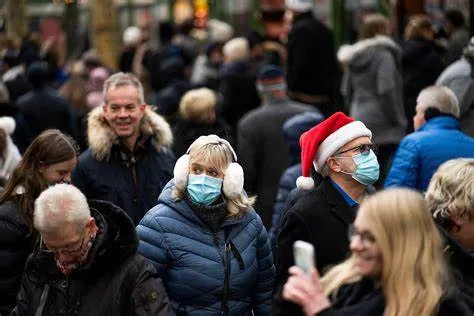In the winter of 2022-2023, both the United States and the United Kingdom faced an unprecedented surge in viral infections. This unprecedented increase in cases has been described by health experts as a “quad-demic,” referring to the simultaneous circulation of four distinct viral illnesses: influenza (flu), respiratory syncytial virus (RSV), COVID-19, and the common cold, all impacting populations in both countries. This phenomenon, with its complex interplay of multiple viral infections, has placed immense strain on healthcare systems already reeling from the long-term effects of the COVID-19 pandemic.
As these viruses sweep through communities simultaneously, they pose unique challenges for both medical professionals and public health authorities. This article provides an in-depth look at the quad-demic, explaining the causes, implications, and how the US and UK are attempting to manage this complex situation.
What Is a Quad-Demic?
The term “quad-demic” is a relatively new concept that has emerged as a way to describe the convergence of four viral respiratory infections in a single season. Each of these viruses is typically seasonal, peaking in different months, but the collision of all four in the winter months has significantly compounded the challenges faced by healthcare systems.
- Influenza (Flu): Influenza is one of the most well-known seasonal viruses, typically surging during the winter months. The flu leads to high hospitalization rates, particularly among vulnerable populations such as the elderly, children, and individuals with compromised immune systems.
- Respiratory Syncytial Virus (RSV): RSV is a common respiratory virus that usually affects children and the elderly. While most people recover from RSV with mild symptoms, it can be severe for young children, particularly infants, and the elderly, leading to bronchiolitis and pneumonia.
- COVID-19: Despite widespread vaccinations and improved treatments, COVID-19 continues to circulate and cause illness, particularly in the winter months. With the emergence of new variants, the virus has remained a significant public health concern.
- Common Cold (Rhinovirus): The common cold, caused by rhinoviruses, is another major respiratory infection that peaks during the winter months. While it is typically milder than other viral infections, it still contributes to a significant number of missed work and school days.
The simultaneous circulation of these four viruses has overwhelmed hospitals, increased the number of doctor’s visits, and placed immense pressure on medical resources. It has become clear that the traditional focus on individual viral outbreaks is no longer enough to address the broader challenges posed by these concurrent infections.
The Impact of the Quad-Demic on Healthcare Systems
Overburdened Hospitals and Healthcare Workers
One of the most immediate consequences of the quad-demic is the overwhelming of healthcare systems. Hospitals have been stretched to their limits, with emergency rooms experiencing a higher volume of patients than usual. Many hospitals in both the US and the UK reported record numbers of pediatric cases of RSV, while flu and COVID-19 cases were also on the rise.
This surge in patients has placed a heavy burden on healthcare workers, who were already fatigued from the COVID-19 pandemic. The strain on medical staff, from doctors and nurses to support personnel, has contributed to increased burnout, higher stress levels, and an overall decline in the quality of care provided to patients. This has led to concerns about healthcare worker shortages, which could worsen if the quad-demic continues to intensify.
Delays in Medical Care
As hospitals reach capacity and staff are stretched thin, delays in medical care have become an unfortunate reality. Patients may face extended wait times in emergency departments, and elective procedures may be postponed to allocate resources for critical care. Those requiring immediate attention for flu, RSV, or COVID-19 may not receive the care they need in a timely manner, exacerbating the risk of severe complications and death.
Moreover, healthcare workers who are themselves affected by illness are unavailable to treat patients, further reducing the healthcare workforce. This vicious cycle of increasing demand and decreasing supply of medical professionals has resulted in a healthcare crisis in many regions.
The Viruses Behind the Quad-Demic
Influenza (Flu)
Influenza is caused by the influenza virus, which can mutate from year to year, making it challenging to predict and prevent. In the 2022-2023 season, influenza rates were notably high in both the US and the UK, with both countries reporting a surge in cases. In the US, the Centers for Disease Control and Prevention (CDC) reported that flu cases reached epidemic levels early in the season, much earlier than expected.
The flu presents with symptoms such as fever, chills, cough, sore throat, body aches, and fatigue. Severe complications can include pneumonia, hospitalization, and, in some cases, death. Vulnerable populations, including the elderly, young children, and individuals with pre-existing medical conditions, are most at risk of developing severe flu-related complications.
Respiratory Syncytial Virus (RSV)
RSV is a virus that primarily affects the respiratory tract, causing symptoms such as coughing, wheezing, and difficulty breathing. It is especially dangerous for infants and older adults, who are at risk of developing severe complications, including bronchiolitis and pneumonia. During the quad-demic, RSV cases surged to alarming levels, causing a shortage of pediatric hospital beds in the US and the UK.
For children under two, RSV is the leading cause of hospitalization for respiratory illness. In fact, most children will have had an RSV infection by the time they are two years old. However, some children experience more severe illness and require hospitalization. The impact of RSV on hospitals was particularly severe during the winter of 2022-2023, where healthcare systems struggled to manage the influx of pediatric RSV patients.
COVID-19
COVID-19, caused by the SARS-CoV-2 virus, continues to circulate even as many countries have shifted their focus to managing endemic conditions. New variants, such as Omicron and its subvariants, have contributed to increased transmissibility and a higher rate of reinfections. Despite the availability of vaccines and antiviral treatments, the sheer volume of cases during the quad-demic led to increased hospitalizations, particularly among individuals with weakened immune systems.
COVID-19 symptoms include fever, cough, shortness of breath, fatigue, and loss of taste or smell. More severe cases can result in pneumonia, acute respiratory distress syndrome, and long-term complications known as “long COVID.” As with RSV and flu, the most vulnerable populations are at the greatest risk, including the elderly, immunocompromised individuals, and those with pre-existing conditions.
Common Cold (Rhinovirus)
The common cold, caused primarily by rhinoviruses, is a mild but widespread viral infection. Although it is usually not as severe as the flu, COVID-19, or RSV, it still contributes to the overall burden of viral infections, especially during the winter months. The symptoms of the common cold include a runny nose, sore throat, sneezing, mild cough, and fatigue.
Despite being less dangerous than other respiratory illnesses, the common cold leads to millions of missed school and workdays each year, putting additional pressure on healthcare systems and economies. The quad-demic situation made it even harder to differentiate between cold symptoms and those caused by other, more severe viral infections.
Managing the Quad-Demic: Responses in the US and UK
Vaccination and Preventive Measures
One of the most effective ways to combat the quad-demic is through vaccination. Both the US and the UK have long-standing flu vaccination programs, which were ramped up during the COVID-19 pandemic. The COVID-19 vaccine rollout in both countries helped reduce the severity of illness and hospitalizations but did not eliminate the virus entirely.
For RSV, there is currently no vaccine available, though research is underway to develop one. Preventive measures for RSV primarily focus on good hygiene, avoiding exposure, and maintaining a clean environment. Public health campaigns in both the US and the UK encouraged handwashing, mask-wearing, and social distancing to prevent the spread of respiratory viruses during the winter months.
Healthcare System Adjustments
Both countries have had to make adjustments to their healthcare systems in response to the quad-demic. Hospitals have had to scale up their capacity, including increasing the number of available beds, extending hours for urgent care services, and implementing protocols to manage the large influx of viral infections.
In the US, temporary field hospitals were set up in areas with the highest surge in cases, while in the UK, the National Health Service (NHS) delayed some elective surgeries to focus on urgent care. Additionally, both countries emphasized the importance of early testing and diagnosis to differentiate between the four viruses, ensuring that patients receive the appropriate treatment.
Long-Term Implications
As the world grapples with the quad-demic, experts warn that this may not be the last time such a convergence of viruses occurs. Climate change, global travel, and the ongoing evolution of viruses like SARS-CoV-2 and influenza may make future quad-demics more frequent. Public health strategies will need to adapt to these new challenges, including improving viral surveillance, promoting vaccination, and bolstering healthcare capacity.
Moreover, the mental and emotional toll of the quad-demic should not be overlooked. Healthcare workers, patients, and the general public are experiencing pandemic fatigue, which may lead to challenges in adherence to public health measures and increased stress on mental health services.
The quad-demic of 2022-2023, characterized by the simultaneous spread of influenza, RSV, COVID-19, and the common cold, has highlighted the vulnerability of global healthcare systems and the need for robust public health responses.























